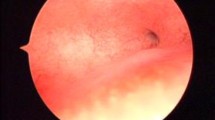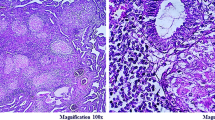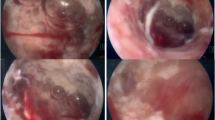Abstract
Objective
To demonstrate the association between genital endometrial tuberculosis and Asherman's syndrome.
Materials and methods
A total of 28 women who underwent hysteroscopy with or without laparoscopy for suspected Asherman’s syndrome from symptoms (amenorrhoea or oligomenorrhoea, and or primary or secondary infertility) and who were found to have genital tuberculosis on endometrial biopsy (histopathology or culture) or positive polymerase chain reaction (PCR) on endometrial aspirate or positive findings of tuberculosis on laparoscopy or hysteroscopy were enrolled in this retrospective study.
Results
The mean age and parity were 26.5 years and 0.3, respectively. There was past history of TB in 67.8% women. All women had menstrual dysfunction, with oligomenorrhoea and hypomenorrhoea in 16 (57%) women and amenorrhoea in 12 (42.8%). All women had primary (n = 19, 67.8%) or secondary (n = 9, 32%) infertility. On hysteroscopy, there were various grades of adhesions in all women, with grade I in 17.8%, grade II in 28.5%, grade III in 28.5% and grade IV in 17.5% women. Only four women (14.3%) had open ostia, while others had bilateral (28.5%) or unilateral (21.3%) blocked ostia or inability to see ostia (28.5%). On laparoscopy performed on 18 women, there were varying grades of adhesions in 16 (88.8%) women, with beading (33.3%), tubercles (33.3%), caseation (11.1%) and tubo-ovarian masses (11.1%). The diagnosis of genital TB was made by histopathology (tuberculous granuloma) on endometrial biopsy in 28.6%, positive culture in 3.6%, positive polymerase chain reaction (PCR) in 46.4% and observation of tubercles, beading or caseation on laparoscopy in 17.8% or shaggy cavity with caseation on hysteroscopy in 3.6% women.
Conclusion
Genital tuberculosis appears to be an important and common cause of Asherman's syndrome in India, causing oligomenorrhoea or amenorrhoea with infertility.
Similar content being viewed by others
References
WHO report on the TB epidemic (1994) TB, a global emergency. WHO/TB/94.177, World Health Organisation, Geneva
Dye C, Watt CJ, Bleed DM, Hosseini SM, Raviglione MC (2005) Evolution of tuberculosis control and prospects for reducing tuberculosis incidence, prevalence and deaths globally. JAMA 293:2767–2775
World Health Organisation (2006) Global tuberculosis control: surveillance, planning, financing. WHO/HTM/TB, World Health Organisation, Geneva, p 362
Sharma JB (2007) Female genital tuberculosis revisited. Obstet Gynaecol Today XII:61–63
Schaefer G (1976) Female genital tuberculosis. Clin Obstet Gynaecol 19:223–239
Kumar S (2001) Female genital tuberculosis. In: Sharma SK, Mohan A (eds) Tuberculosis, 1st edn. Jaypee, Delhi, pp 311–324
Gupta N, Sharma JB, Mittal S, Singh N, Misra R, Kukreja M (2007) Genital tuberculosis in Indian infertility patients. Int J Gynaecol Obstet 97(2):135–138, Epub, 23 Mar 2007
Sharma JB, Malhotra M, Arora R (2003) Fitz Hugh Curtis syndrome as a result of genital tuberculosis: a report of three cases. Acta Obstet Gynecol Scand 82(3):295–297
Bazaz Malik G, Maheshwari B, Lal N (1983) Tuberculosis endometritis: a clinicopathological study of 1,000 cases. Br J Obstet Gynaecol 90:84–86
Asherman JG (1960) The myth of tubal and endometrial transplantation. Br J Obstet Gynecol 67(2):228–233
Neuwirth RS (1993) Gynecologic surgery and adhesion prevention: Asherman’s syndrome. Prog Clin Biol Res 381:187–190
Westendorp IC, Ankum WM, Mol BW, Vonk J (1998) Prevalence of Asherman’s syndrome after secondary removal of placental remnants or a repeat curettage for incomplete abortion. Human Reprod 13(12):3347–3350
Schenker JG (1996) Etiology of and therapeutic approach to synechia uteri. Eur J Obstet Gynecol Reprod Biol 65(1):109–113
Smid A, Borsos A, Takacs I (1980) Aetiology of Asherman’s syndrome (intra-uterine synechia). Zentralbl Gynakol 102(7):380–385
Schiaff WD, Hurst BS (1995) Preoperative sonographic measurement of endometrial pattern predicts outcome of surgical repair in patients with severe Asherman’s syndrome. Fertil steril 63(2):410–413
Bacelar AC, Wilcock D, Powell M, Worthington BS (1995) The value of MRI in the assessment of traumatic intra-uterine adhesions (Asherman’s syndrome). Clin Radiol 50(2):80–83
Cohen MA, Sauer MV, Keltz M, Lindheim SR (1999) Utilising routine sonohysterography to detect intrauterine pathology before initiating hormone replacement therapy. Menopause 6(1):68–70
Sciarra JJ (1997) Simplified therapy for Asherman’s syndrome. Fertil Steril 68(6):1047–1050
Broome JD, Vancaillie TG (1999) Fluoroscopically guided hysteroscopic division of adhesions in severe Asherman syndrome. Obstet Gynaecol 93(6):1041–1043
Magos A (2002) Hysteroscopic treatment of Asherman’s syndrome. Reprod Biomed Online 4(Suppl 3):46–51
March CM, Isreal R, March AD (1978) Hysteroscopic management of intrauterine adhesions. Am J Obstet Gynecol 130:653
Wamsteker K (1984) Hysteroscopy in Asherman’s syndrome. In: Siegler AM, Lindemann HJ (eds) Hysteroscopy: principles and practice. Lippincott, Philadelphia, pp 198–203
American Fertility Society (1988) The American Fertility Society of adnexal adhesions, distal tubal occlusions, secondary to tubal ligation, tubal pregnancy, mullerian anomalies and intrauterine adhesions. Fertil Steril 49:944–955
Valle RF, Sciarra JJ (1988) Intrauterine adhesions: hysteroscopic diagnosis, classification, treatment and reproductive outcome. Am J Obstet Gynecol 158:1459–1470
Donnez J, Nisolle M (1994) Hysteroscopic lysis of intrauterine adhesions (Asherman’s syndrome). In: Donnez J (ed) Atlas of laser operative laparoscopy and hysteroscopy. Parthenon Pub Group, London, pp 305–322
Newton JR, Mackenzie WE, Emens MJ, Jordan JA (1989) Division of uterine adhesions (Asherman’s syndrome) with the Nd-YAG laser. Br J Obstet Gynaecol 96(1):102–104
Fernandez H, Al-Najjar F, Chauveaud-Lambling A, Frydman R, Gervaise A (2006) Fertility after treatment of Asherman’s syndrome stage 3 and 4. J Minim Invasive Gynecol 13(5):398–402
Shiau CS, Hsieh CC, Chiang CH, Hsieh TT, Chang MY (2005) Intrapartum spontaneous uterine rupture following uncomplicated resectoscopic treatment of Asherman’s syndrome. Chang Gung Med J 28(2):123–127
Jindal UN (2006) An algorithmic approach to female genital tuberculosis causing infertility. Int J Tuber Lung Dis 10:1045–1050
Author information
Authors and Affiliations
Corresponding author
Rights and permissions
About this article
Cite this article
Sharma, J.B., Roy, K.K., Pushparaj, M. et al. Genital tuberculosis: an important cause of Asherman’s syndrome in India. Arch Gynecol Obstet 277, 37–41 (2008). https://doi.org/10.1007/s00404-007-0419-0
Received:
Accepted:
Published:
Issue Date:
DOI: https://doi.org/10.1007/s00404-007-0419-0




